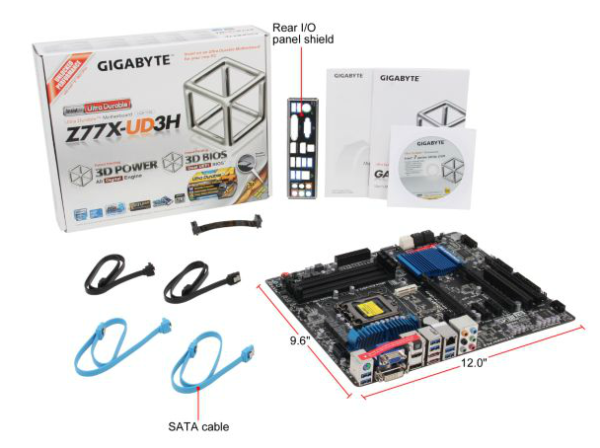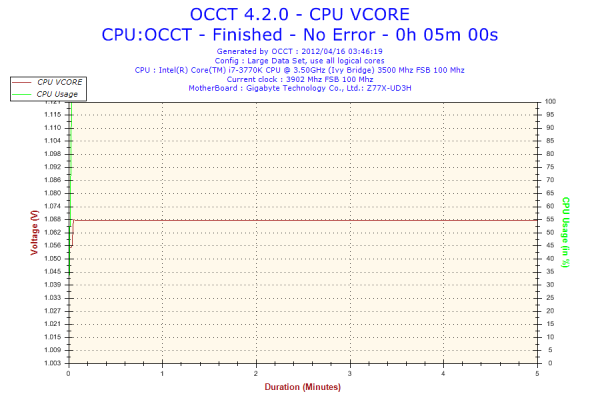Intel Z77 Motherboard Review with Ivy Bridge - ASRock, ASUS, Gigabyte, and MSI
by Ian Cutress on May 7, 2012 7:40 PM EST- Posted in
- Motherboards
- MSI
- Gigabyte
- ASRock
- Asus
- Ivy Bridge
- Z77
Gigabyte GA-Z77X-UD3H - In The Box
Over the past several motherboard generations, I have not been that impressed with Gigabyte's offering in terms of extras - this is because in order to hit a price point, sometimes the extras in the box are not the focus of the product. With the Z77X-UD3H, we are hoping for at least some good stuff here.
Driver CD
User Manual
IO Shield
Four SATA Cables
One long SLI bridge
Voltage Readings
Using OCCT we monitor the voltage change of the motherboard under load. This represents the direct correlation between the Load Line Calibration and how the processor/motherboard deals with voltage requests while under load. This is not to be confused with the quality of power delivery, but more an indication of how aggressive the default LLC settings are on a motherboard.
The response of the Gigabyte board under load is fantastic. No ripple at all and a lower average voltage than the ASUS P8P77-V Pro.
Overclocking
Note: Ivy Bridge does not overclock like Sandy Bridge. For a detailed report on the effect of voltage on Ivy Bridge (and thus temperatures and power draw), please read Undervolting and Overclocking on Ivy Bridge.
The Gigabyte GA-Z77X-UD3H has a variety of overclocking tools at the disposal of the user. Automatic overclocks are through EasyTune6, where we experienced a rather good result with our chip with Gigabyte's auto tuning software, and manual overclocks are either performed through the BIOS (with a series of menu jumps which should have been more carefully laid out), or using a new Gigabyte tool called TweakLauncher. I have not previewed TweakLauncher here, as it is primarily for sub-zero overclockers wanting real-time access to changes in performance while under extreme temperatures. It forgoes the usual GUI interface and sliders with something more amenable to the competitive overclocker - it is not suitable for the majority of users.
Auto Overclock: Using the Auto Tuning option in EasyTune6, the software pulled up a large screen and offered a confirmation of a stress-tested overclock. When clicked yes, the system would stability test a range of BCLK and Multipliers until the board resets or the system finds it unstable. When this had finished, the board offered me a 46x104.5 overclock (4810 MHz). I discovered that turbo modes still applied, so this speed was the single thread speed, and the CPU would reduce the multiplier by two for multithreaded loads, giving 4589 MHz). This gave 1.236 volts at load, which could be a little high, but due to the lower speed under multithreaded load, the CPU only reached 84ºC under PovRay and was completely stable. I enjoyed this result a lot from an automatic overclock!
Manual Overclock: Due to the way Ivy Bridge behaves with increased voltage, for a manual overclock, I am testing the peak overclock at a variety of voltages as well as the temperatures at that voltage. On the Gigabyte board, the CPU load line calibration was set to Extreme and Intel Speed Step was disabled. One interesting thing to note was that Gigabyte set this board to 100.9 MHz default on the BCLK, rather than 100.0 MHz. When the multiplier is pushed above 44x, this is reduced to 100.0 MHz.
At 1.100 volts, the highest multiplier that was stable was 45x, giving 4.5 GHz. This gave 70ºC at load with PovRay, and showed a load voltage of 1.116 volts.
At 1.150 volts, the highest multiplier that was stable was 46x, giving 4.6 GHz. This gave 75ºC at load with PovRay, and showed a load voltage of 1.164 volts.
At 1.200 volts, the highest multiplier that was stable was 47x, giving 4.7 GHz. This gave 82ºC with PovRay, 86ºC with OCCT, and a load voltage of 1.212 volts.
At 1.250 volts, the board successfully booted at 4.8 GHz, with 1.272 volts under load and 89ºC with PovRay - but this was not stable due to the memory errors in PovRay, suggesting more voltage is required. Given the current load temperature, I was unwilling to push the voltage further.
In terms of memory, when attempting to overclock a G.Skill 2x4 DDR3-2666 kit, which performed 2950 MHz on the ASUS P8Z77-V Pro, it would not boot at the DDR3-2800 strap despite all the correct timings being entered.












117 Comments
View All Comments
drbuzbee - Thursday, May 10, 2012 - link
The Lan read and write sequential speeds are labeled MBytes ps but undoubtedly are reported in Mbits ps.millisec - Thursday, May 10, 2012 - link
The Gigabyte UD3 is a nice board but it's a little annoying that's the board GB keeps sending out for reviews because of the $160 price mark. For $29 more you get so much more in the UD5 with Realtek audio, dual lan with Intel/Atheros, PCI 3.0 X4 slot, more sata 3 ports and second Marvell raid controller. The extra $29 buys a lot vs. the UD3 and in IMO is a much better value. Just hoping the UD5 arriving today does not have the same problems with the G.Skill Ripjaws X 2400 kit Anand had. Won't be a happy camper...Zoomer - Tuesday, May 15, 2012 - link
$29 for extra sata ports = pass. ;)embeddedbill - Friday, May 11, 2012 - link
Hi Ian, any chance you will have an update on this board?embeddedbill - Friday, May 11, 2012 - link
What... Did that take about 3 minutes from this question to Anands article?smalM - Friday, May 11, 2012 - link
Black connectors, video ports, PS/2 - the first manufacturer who omits all that nonsense will get my money.KivBlue - Friday, May 11, 2012 - link
Gigabyte has gone cheap for sure, I have compared the specs for both on-board audio chips and Realtek clearly has more feature sets. Plus VIA interface looks hideous. My current system's motherboard is Gigabyte and while they have improved things with UEFI, the feature set they have in it is pretty much the same as the old BIOS, ASUS clearly has a more comprehensive UEFI in that regard, I would go with ASUS motherboard in the future as I'm no longer a novice and someone who wants to take full control of a system.bobster1 - Sunday, May 13, 2012 - link
I've been debugging crashes at stock and overclock for a few days and finally seem to have found the cause, and thought it was worth mentioning here as I didn't see anything about it in the article.I was finding my 7970 crossfire/UD3h/3770k setup was locking up frequently in games like the Witcher 2 - the system would freeze and had to be turned off and on again. I discovered by accident that the games became stable if I had prime95 running in the background, and eventually concluded that it must have something to do with the voltages at lighter loads. When I bumped up the voltage to 1.25v in the BIOS (using the static setting, rather than dynamic voltage), it seems to have solved the problem. I'm guessing this is due to Ivy Bridge taking responsibility for pci-e; it's rather unfortunate as it means I can't let the cpu use a lower voltage in an idle state without it rendering the system unstable when rendering 3d.
mikeyd55 - Tuesday, June 19, 2012 - link
Hi,First, thank you for addressing this important benchmark!
Your article notes that POST times can be improved by disabling non essential controllers.
It would be helpful to know, with the minimum controllers enabled to support a system built on either the PRO or DELUXE (Asus) boards, with: one NIC enabled in OS (only?), boot from one SSD and/or one optical drive connected to Z77 chipset ports (no third party storage controller needed), USB disabled on boot, but enabled in OS (if possible as with certain Intel boards?), and any Wireless option disabled, what could be expected.
Conditioned - Wednesday, June 20, 2012 - link
So how was dpc measured? If you disable intel-c state and all other powersaving features it makes an absolutely huge difference in dpc.